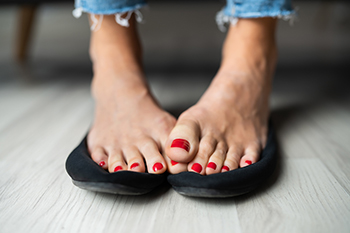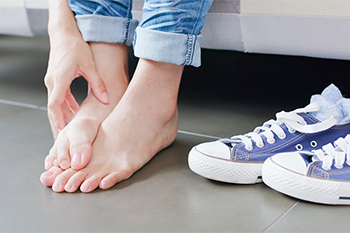
Wilmington (937) 382-2347
Fax
(513) 932-1606

Wilmington (937) 382-2347
Fax
(513) 932-1606

The medical term used when referring to excessively sweaty feet is plantar hyperhidrosis. Approximately five percent of the population is affected by this condition. Foot conditions like athlete’s foot and toenail fungus can accompany plantar hyperhidrosis in addition to an odor emanating from the feet. Hyperhidrosis results from the overproduction of sweat glands in the feet and may cause discomfort and embarrassment. Research suggests that it may be beneficial to keep a journal of sweating episodes to help pinpoint triggers, such as eating certain foods or emotions that may cause anxiety. It is best to avoid wearing socks that are made from nylon materials, unlike cotton socks which may help to ensure proper ventilation. Additionally, staying hydrated may lessen the intensity of sweaty feet. Please schedule an appointment with a podiatrist who can perform tests to determine if your feet are excessively sweaty as well as the treatment method that is best for you.
If you are suffering from hyperhidrosis contact Dr. Gerald Perelman of Ohio. Our doctor can provide the care you need to attend to all of your foot and ankle needs.
Hyperhidrosis of the Feet
Hyperhidrosis is a rare disorder that can cause people to have excessive sweating of their feet. This can usually occur all on its own without rigorous activity involved. People who suffer from hyperhidrosis may also experience sweaty palms.
Although it is said that sweating is a healthy process meant to cool down the body temperature and to maintain a proper internal temperature, hyperhidrosis may prove to be a huge hindrance on a person’s everyday life.
Plantar hyperhidrosis is considered to be the main form of hyperhidrosis. Secondary hyperhidrosis can refer to sweating that occurs in areas other than the feet or hands and armpits. Often this may be a sign of it being related to another medical condition such as menopause, hyperthyroidism and even Parkinson’s disease.
In order to alleviate this condition, it is important to see your doctor so that they may prescribe the necessary medications so that you can begin to live a normal life again. If this is left untreated, it is said that it will persist throughout an individual’s life.
A last resort approach would be surgery, but it is best to speak with your doctor to find out what may be the best treatment for you.
If you have any questions please feel free to contact our office located in Wilmington, OH . We offer the newest diagnostic and treatment technologies for all your foot and ankle needs.

The foot condition known as gout can cause permanent damage to the tendons and joints if prompt medical attention is not sought. It is considered to be a chronic disease, in addition to being a form of arthritis. The big toe is often affected and can be painful and uncomfortable. Gout is caused by an excess of uric acid in the bloodstream and can form crystals that lodge in the joints of the big toe. This condition can develop due to genetics or from eating foods that have high levels of purines. These can include shellfish, red meat, alcohol, and drinks that are made with large amounts of sugar. Some patients have said they experience pain that is so intense it can be impossible to walk up the steps. Gout attacks may be reduced by implementing healthy lifestyle habits into daily living routines. These can consist of losing weight if applicable, exercising regularly, and drinking plenty of water. If you are afflicted with gout, it is strongly advised that you are under the care of a podiatrist who can help you to manage this condition.
Gout is a painful condition that can be treated. If you are seeking treatment, contact Dr. Gerald Perelman from Ohio. Our doctor will treat your foot and ankle needs.
What Is Gout?
Gout is a form of arthritis that is characterized by sudden, severe attacks of pain, redness, and tenderness in the joints. The condition usually affects the joint at the base of the big toe. A gout attack can occur at any random time, such as the middle of the night while you are asleep.
Symptoms
Risk Factors
Prior to visiting your podiatrist to receive treatment for gout, there are a few things you should do beforehand. If you have gout you should write down your symptoms--including when they started and how often you experience them, important medical information you may have, and any questions you may have. Writing down these three things will help your podiatrist in assessing your specific situation so that he or she may provide the best route of treatment for you.
If you have any questions, please feel free to contact our office located in Wilmington, OH . We offer the newest diagnostic and treatment technologies for all your foot care needs.

Athlete’s foot is one of the many foot conditions that can reduce and diminish the health of your feet. Caused by a fungal infection, Athlete’s foot can facilitate the development of a rash between the toes. There are several complications of this condition to be aware of. First, if you have a case of athlete’s foot, it may be possible to develop a bacterial infection as well. This is especially common when the athlete’s foot is not addressed for some time. The bacterial infection can develop as a result of scratching at the affected area. Second, another important complication of athlete’s foot to be aware of is that it may spread to other parts of the body. For example, since athlete’s foot is contagious, if you are scratching the affected area, the fungal infection can spread to your hands, the groin, or underneath the nails. If you have athlete’s foot, contact a podiatrist today for treatment.
Athlete’s foot is an inconvenient condition that can be easily reduced with the proper treatment. If you have any concerns about your feet and ankles, contact Dr. Gerald Perelman from Ohio. Our doctor will treat your foot and ankle needs.
Athlete’s Foot: The Sole Story
Athlete's foot, also known as tinea pedis, can be an extremely contagious foot infection. It is commonly contracted in public changing areas and bathrooms, dormitory style living quarters, around locker rooms and public swimming pools, or anywhere your feet often come into contact with other people.
Solutions to Combat Athlete’s Foot
Athlete’s foot can cause many irritating symptoms such as dry and flaking skin, itching, and redness. Some more severe symptoms can include bleeding and cracked skin, intense itching and burning, and even pain when walking. In the worst cases, Athlete’s foot can cause blistering as well. Speak to your podiatrist for a better understanding of the different causes of Athlete’s foot, as well as help in determining which treatment options are best for you.
If you have any questions please feel free to contact our office located in Wilmington, OH . We offer the newest diagnostic and treatment technologies for all your foot and ankle needs.

Children’s feet are not just smaller than adult feet. They are shaped differently, and will change as they grow. During the first year of life, children’s feet are soft and supple and have ample fat pads on the soles. The arch of the foot begins to develop when a child starts to walk. The muscles become stronger as the feet grow in length and width. Before children begin to walk, their feet do not need to be covered except for warmth and hygiene. In fact, footwear that is too tight can interfere with the growth and development of their feet. Even when a child starts to walk, shoes are not needed indoors. Walking barefoot can help their feet grow normally, develop muscle tone, strength, and toe grasping action. While outside, a child’s feet should be protected by lightweight, flexible footwear. Shoes for young children should provide a degree of foot cushioning, stability, and foot flexibility. It is wise to check your child’s feet frequently to make sure their footwear is the correct size which may help to prevent foot issues from arising. If you are unsure of how to take care of your child’s feet or have questions about choosing appropriate footwear, consult a podiatrist who can help you.
Making sure that your children maintain good foot health is very important as they grow. If you have any questions, contact Dr. Gerald Perelman of Ohio. Our doctor can provide the care you need to keep you pain-free and on your feet.
Keeping Children's Feet Healthy
Having healthy feet during childhood can help prevent medical problems later in life, namely in the back and legs. As children grow, their feet require different types of care. Here are some things to consider...
Although babies do not walk yet, it is still very important to take care of their feet.
Avoid putting tight shoes or socks on his or her feet.
Allow the baby to stretch and kick his or her feet to feel comfortable.
As a toddler, kids are now on the move and begin to develop differently. At this age, toddlers are getting a feel for walking, so don’t be alarmed if your toddler is unsteady or ‘walks funny’.
As your child gets older, it is important to teach them how to take care of their feet.
Show them proper hygiene to prevent infections such as fungus.
Be watchful for any pain or injury.
Have all injuries checked by a doctor as soon as possible.
Comfortable, protective shoes should always be worn, especially at play.
If you have any questions please feel free to contact our office located in Wilmington, OH . We offer the newest diagnostic and treatment technologies for all your foot and ankle needs.